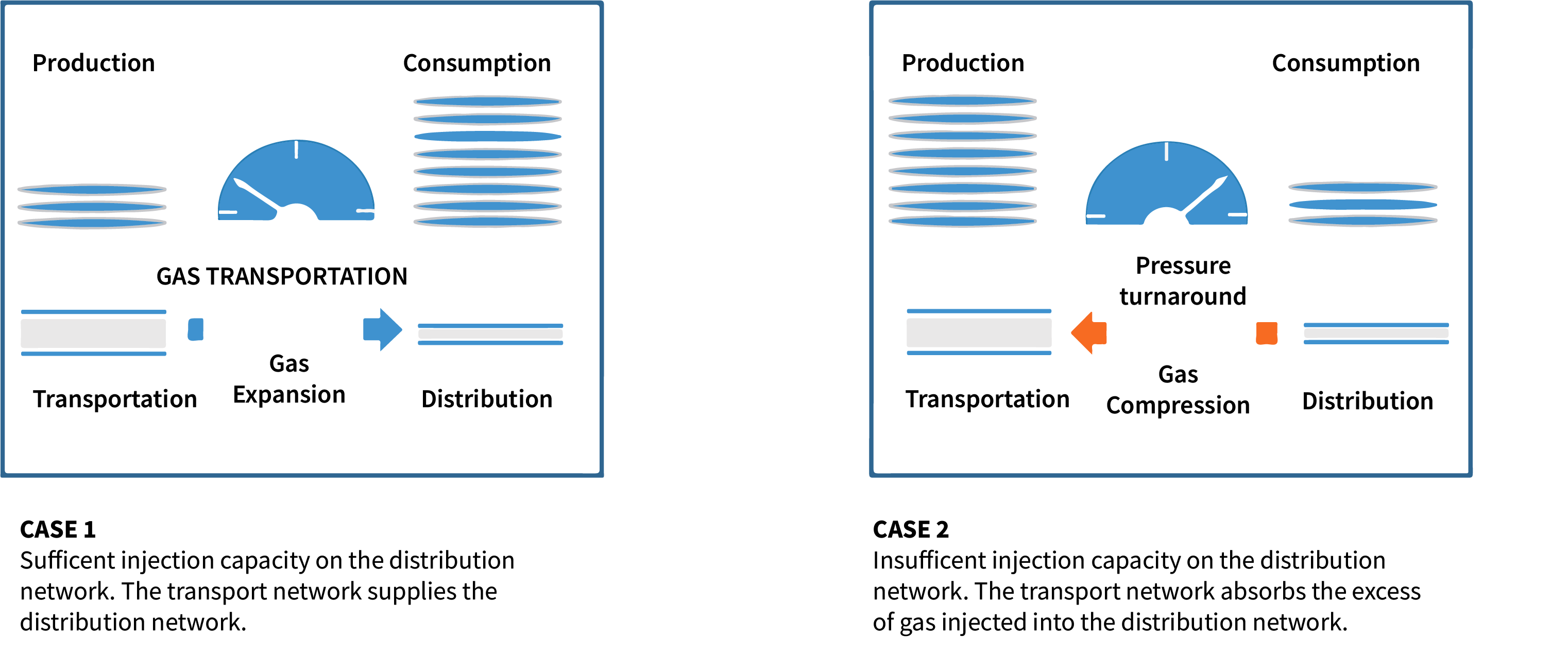Biomethane
Introduction:
⠀⠀⠀
In France, there has been a sharp increase in gas consumption on the transport network since 2017 (+4.6%). The factor contributing to this increase was the rise in demand for gas from the industrial market (+10.7% in 2017) for the production of electricity, chemicals, agrifood and metallurgy. Injections of biomethane into gas networks have doubled and to avoid saturation and the consequent dispersion of excess gas, a number of solutions have been put in place, such as temporary storage and the reverse flow technique (Grid reverse flow).
Technique:
⠀⠀⠀
The reverse flow technique consists of compressing unconsumed biomethane on a distribution network and then injecting it into the higher pressure network. This allows the biomethane to be piped to a more distant consumption area, avoiding burning it or venting it into the atmosphere. Its operation is automatic: when the network pressure reaches a high threshold (as a result of low consumption), the compressor unit starts up automatically; by compressing the biomethane, it causes the pressure to increase and the excess is channelled into another network, allowing the initial network pressure to be reduced until the minimum threshold is reached, at which point the compressor will stop. These compression systems make it possible to maximise the efficiency of the entire energy system since, by means of pressure changes, they enable the circulation of any surplus gas on upstream networks for immediate consumption or, alternatively, into storage units for future consumption.
Advantages and features of the SAFE solution:
SAFE supplied 8 highly engineered systems with the following characteristics:
Operational versatility and high performance of the compression unit
The compressor units, consisting of 2 SVs and 6 SWs – with direct coupling to the electric motor – operate across a wide pressure range with high efficiency. In addition, 0%-100% regulation of the flow rate is ensured by a combination of VFD and recirculation line.
For more details on suction and discharge pressures as well as the maximum flow rate of each compressor unit, the following table defines the operating range for each unit:
| | Site 1 | Site 2 | Site 3 | Site 4 | Site 5 | Site 6 | Site 7 | Site 8 |
|---|---|---|---|---|---|---|---|---|
| Pin (barG) | 3,9 | 4 | 7,5 | 4 | 8 | 7 | 8 | 4 |
| Pout (barG) | 55 | 67,7 | 60 | 67,7 | 67,7 | 67,7 | 67,7 | 67,7 |
| Flow rate (Nm3/h) | 540 | 1,450 x2 | 820 | 1,000 | 1,500 | 1,000 | 3,000 | 1,500 |
| Temp in (°C) | 15 | 15 | 15 | 15 | 15 | 15 | 15 | 15 |
| EM power (kW) | 110 | 250 x2 | 110 | 200 | 250 | 200 | 450 | 315 |
Together with the compressor unit, SAFE supplied a number of auxiliary systems to ensure the following benefits:
Maximum flexibility and availability of the solution thanks to:
• Non Regenerative Dryers (present in 2 of the 8 stations) installed upstream of the compressor unit clean and dry the gas when the water content of the network is too high.
• Cooling systems Water-based gas cooling systems that cool the gas at each stage of compression
High safety levels: the compressor units are installed inside soundproof and weatherproof steel enclosures, the size of which varies depending on the station in question. They are equipped with gas and fire detection systems. To ensure maximum safety, the control panel, which manages both the power and the compressor unit, was designed and installed in a separate room from the mechanical unit.
Zero emissions:
The systems may have a compression unit (from another OEM) with an installed power of 2.2 kW and a maximum flow rate of 3 Nm3/h. This type of compressor unit operates across a wide range of pressures on the suction side (10 to 500 mbarG) and the discharge side (40 to 67.7 barG). It operates automatically and is controlled by the control panel built into the solution: whenever the incoming gas exceeds a pressure of 200 mbarG, the compressor unit is activated, recovering any gas leaks and thus avoiding dispersion into the atmosphere. Once the gas pressure has been reduced to 10 mbarG, the compression unit stops.
